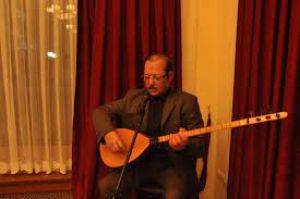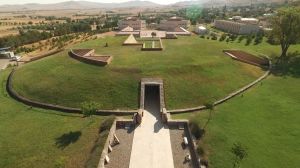The Neşet Ertaş Museum
The Neşet Ertaş Museum
The Neşet Ertaş Museum It is a place dedicated to the life and legacy of Neşet Ertaş, a precious name of Turkish folk music. The museum introduces the instruments of Neşet Ertaş and tells about his contribution to music. In addition, life stories, photographs and selected works of people's ozans in the Kersehir and Keskin regions are also exhibited.
The wax statue of the great master Neşet Ertaş can also be seen here. The museum offers visitors information and experience by focusing on the arts and cultural heritage of the folk genres. Memories of important names such as Muharrem Ertaş and Neşet Ertaş are tried to be kept alive by giving their names in events and architectural works in Kırşehir. In this way, the cultural values and heritage of the people of Kırşehir continue to be preserved. Neşet Ertaş, also known as "Tezenesi of Bozkır". Neşet Ertaş, born in 1938 in the Çiçekdağı district of Kırşehir, is known as a master of the harp and the word.
Neşet Ertaş, who remembers his father carving reeds out of oak wood, has contributed to Turkish folk music with more than 400 works. He is considered to be the last great representative of the culture of stupidity. The famous writer Yaşar Kemal sent his book "Ince Memed" to Neşet Ertaş, signing it as "Bozkırın Tezenesi" and thus making it known as "Bozkırın Tezenesi".
Where is the Neşet Ertaş Museum?
Where is the Neşet Ertaş Museum? The Neşet Ertaş Museum is located very close to the provincial center of Kırşehir. This museum, which has the rich cultural heritage of Kırşehir, stands out as an important area dedicated to the memory of Neşet Ertaş from the people of Kırşehir. The museum offers a unique experience with many details about the life and music of Neşet Ertaş.
Visitors can visit the museum and get an up-close look at Neşet Ertaş's instruments, photographs and private items. They can also touch the life stories and works of other people from Kirshahr and its surroundings. In this way, they can have the opportunity to learn more about the deep history of Turkish folk music and the importance of the representatives of this art.
Plans for a trip to the suburbs and ... What about the slums? You can review our trip plans, if you want. Places to visit in the suburbs You can create your own itinerary on our page.
How to get to the Neşet Ertaş Museum?
How to get to the Neşet Ertaş Museum To get to the Neşet Ertaş Museum, you need to reach the provincial center of Kırşehir. You can get to Kersehir by road, bus or car. If you're coming from somewhere else, you'll have to reach the border of Kırşehir Province before you do.
Happy working hours.
Neşet Ertaş working hours Although Neşet Ertaş passed away on September 25, 2012, his music and art are still alive. The museum serves as an important space that carries the memory and legacy of this valuable artist to future generations. The museum opens its doors to visitors on weekdays between 09:00 and 17:00.
Information about the Joyful Companion
The information about Neşet Ertaş, Turkish folk singer Neşet Ertaş is one of the last great representatives of the Turkmen/Abdallık culture and music tradition. Neşet Ertaş, also known as "Tezenesi of Bozkır", is a name known for his unique music and art, and has made important contributions to Turkish folk music. The Neşet Ertaş Museum, opened in 2017, is named after him and is also known as his home. This museum has opened its doors to visitors as a space dedicated to the life, music and legacy of Neşet Ertaş.
The house where Neşet Ertaş lived has been converted into a museum and is open to visitors. The museum contains Neşet Ertaş's personal belongings, instruments, photographs and information about various periods of his life full of music. Thanks to this museum, you can witness Neşet Ertaş's art and cultural heritage up close, and understand his musical journey and life more closely.
Neşet Ertaş's legacy is preserved as an artist who contributed to the richness of Turkish folk music and is remembered as an important representative of Turkmen/Abdallık culture. The Neşet Ertaş Museum was established with the aim of passing on his valuable art to future generations and offers visitors a cultural experience.
Neşet Ertaş is a folk singer known for his unique style and drum performance, who is considered one of the important representatives of Turkish folk music. Neşet Ertaş was born in 1938 in the village of Kırkgeçit, which belongs to the Çiçekdağı district of Kırşehir. His interest in music began at an early age with his father's harp training. He taught himself to play the harp and sing songs.
He is considered one of the last great representatives of Turkmen and Abdallik culture. Continuing the tradition of folk music, he produced works inspired by the villages and people of Anatolia. Neşet Ertaş, also known as "Tezenesi of Bozkır", impressed the listeners with his lyrics and drum performance, which reflected the melancholy atmosphere of Bozkır, the nature of Anatolia and the feelings of its people.
Ertaş, who has signed more than 400 songs, has worked on traditional Anatolian motifs in these songs. Topics such as love, separation, longing, nature and the daily life of the people are often featured in his songs. Some of Neşet Ertaş's best-known works are songs such as "Where Are You", "Gönül Dağı", "You Turned My Summer Into Winter". In addition to Turkish folk music, it also has an important place in the tradition of semahs and lovers.
In addition to Turkey, he is also known abroad and has given concerts. He has performed in many national and international festivals. Neşet Ertaş died on the 25th of September 2012. However, his works and music still live in the hearts of the Turkish people and music lovers.
His art and music are considered to be part of Turkish culture, and his legacy is being preserved, especially in Kırşehir and throughout Turkey. The Neşet Ertaş Museum in Kırşehir was founded for this purpose. Neşet Ertaş is not only a folk singer, but also an important artist who reflects the spirit of Anatolia. His turks and drumming are considered one of the cornerstones of Turkish folk music.



Değerlendirmeler